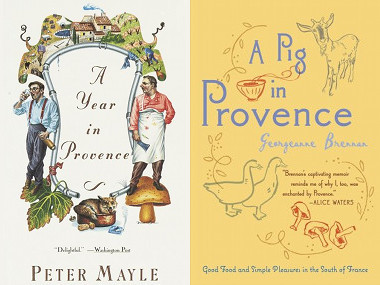A few notes from A Year and A Pig in Provence
I just finished reading two similarly titled books, A Year in Provence, and A Pig in Provence. The former is a bestselling classic of travel literature, chronicling the events that comprise the life of a British couple’s first year after relocating to the Provencal countryside. The latter is more of a food memoir, the story of how Provence left an indelible mark on one woman and her family’s culinary traditions.

A Year was published in 1989, and each chapter concerns a single month from January through December 1987. A Pig was published in 2007, but concerns events primarily from the 1970s. So in a way, they are both rooted in the past, pre-dating even Stephanie’s experience growing up there.
It’s probably not a coincidence that I decided to read these books before embarking on my third trip to France next week. I’m not someone who likes to read up on a place before thrusting myself into it, but since I’ve already had the opportunity to travel there twice, I felt like it was safe to read the perspectives from a few other “outsiders” like myself. What follows are a few of my notes, food-focused, of things that were new to me.
A Year in Provence
Everyone drinks marc. What the heck is marc? Even Stephanie didn’t know. I finally looked it up and discovered that marc is the French word for brandy made from grape skins. To us, it’s better known as the Italian grappa or the French eau-de-vie.
At one point they go to a butcher to get veal for a stew called pebronata. Again Stephanie gave me blank stare. A quick search turns up that it’s a braised veal or pork ragout with peppers and tomatoes. Sounds tasty.
They say the best olive oil is from Maussane-les-Alpilles from the Coopérative Oléicole de la Vallée des Baux. Turns out we drove right through this area during our first trip, when we visited Baux-en-Provence. I think we might even have picked up some oil from a boutique in Baux.
A Pig in Provence
There was a lot of pork offal happening in this book. I’m going to have to keep my eyes open for caillettes, basically organ meat burgers, and pied-et-paquets, tripe “raviolis” in tomato sauce. These are not things I would normally pursue, but given the loving way in which they were described, if I saw either of them on a menu, I’d have to go for it.
There was a lot of discussion of mushroom foraging, centering around three varieties in particular. Chanterelles most everyone has heard of, but cèpes and sanguins I didn’t know. Turns out most Americans know cèpes by their Italian name, porcinis, but I’m unfamiliar with sanguins in any language. Apparently they are known here as saffron milk caps or red pine mushrooms.
Reading this book really made me want to try a real bouillabaisse with rouille. Apparently in Marseilles.
Stephanie’s dad made soupe au pistou (pesto vegetable soup) for us once, but I’d like to have it again. French pistou is essentially Italian pesto without the pine nuts, and optionally gruyere along with or instead of parmesan.
Stephanie’s never had brandade de morue, a pureed salt cod gratin, but it sounds just crazy enough that I’d like to try to make it sometime.
Finally, I think it’s time I get over my lifelong aversion to mayonnaise-like sauces and make a homemade aioli.
thanks for the nice notes/ review… gotta put these on the reading list. have a great time in La Belle France!
Thanks. Didn’t mention it in my notes, but saw anchoïade (tapenade with anchovies) several places in the Antibes outdoor market today. And cèpes! Was so excited, we picked up some fresh cèpe ravioli for lunch. Mmm.